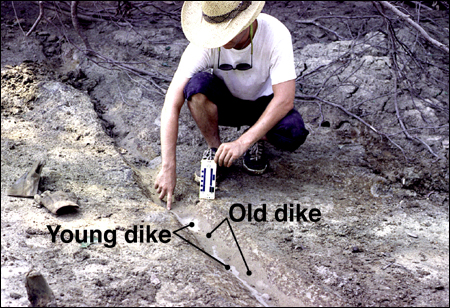

41. The severity of weathering of the clastic infilling in a dike provided guidance to the age of the dike at some places. In this example, an 8-cm-wide dike from the earthquake of 6,100 yr BP is manifest as the brown dike of medium-sized, compact, weathered sand that extends from the bottom-center of the photograph toward the left. The very light-colored filling within the brown dike is a dike from a much, much younger earthquake (perhaps historic), which has intruded the older dike; the younger dike is made up of completely unweathered, medium-sized, extremely loose sand. Such unweathered dikes were restricted to being contained entirely within the older dikes along a 10-km-long portion of a river in the study area. Dikes commonly form in exactly the same location even though the earthquakes that formed them are widely spaced in time. Because severe liquefaction often causes loosening of a thin (0.33 to 1 m) sand zone immediately beneath the fine-grained cap, that sand zone is even more susceptible to liquefaction than it was before the earthquake.
For more information, contact Stephen F. Obermeier